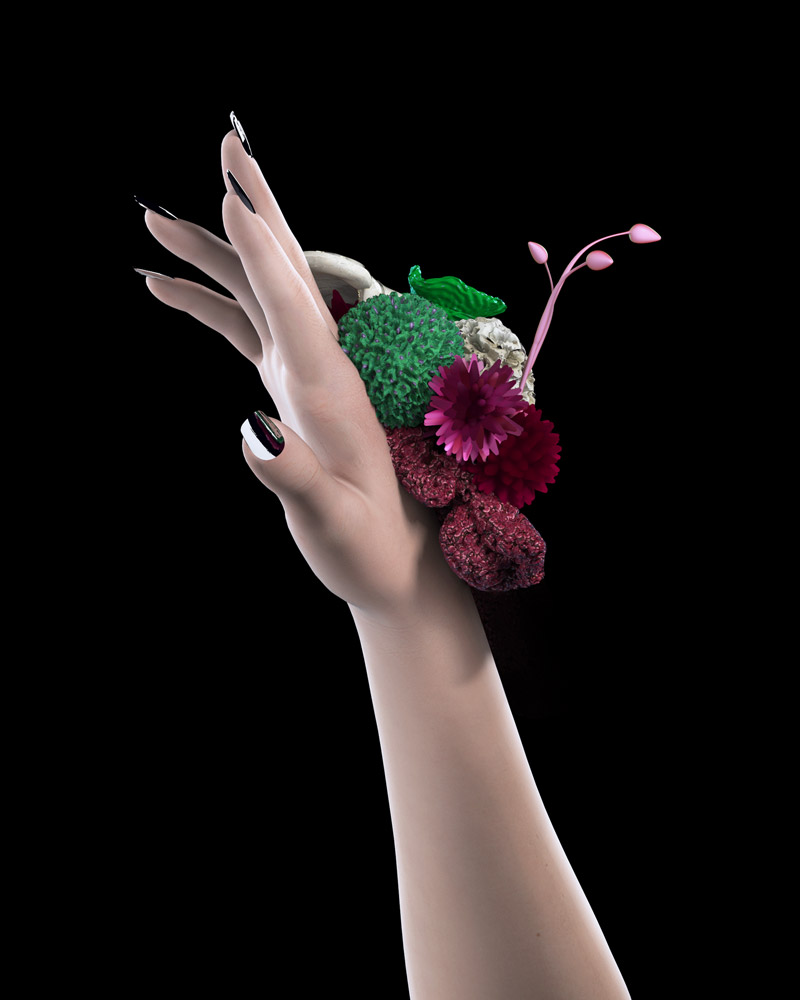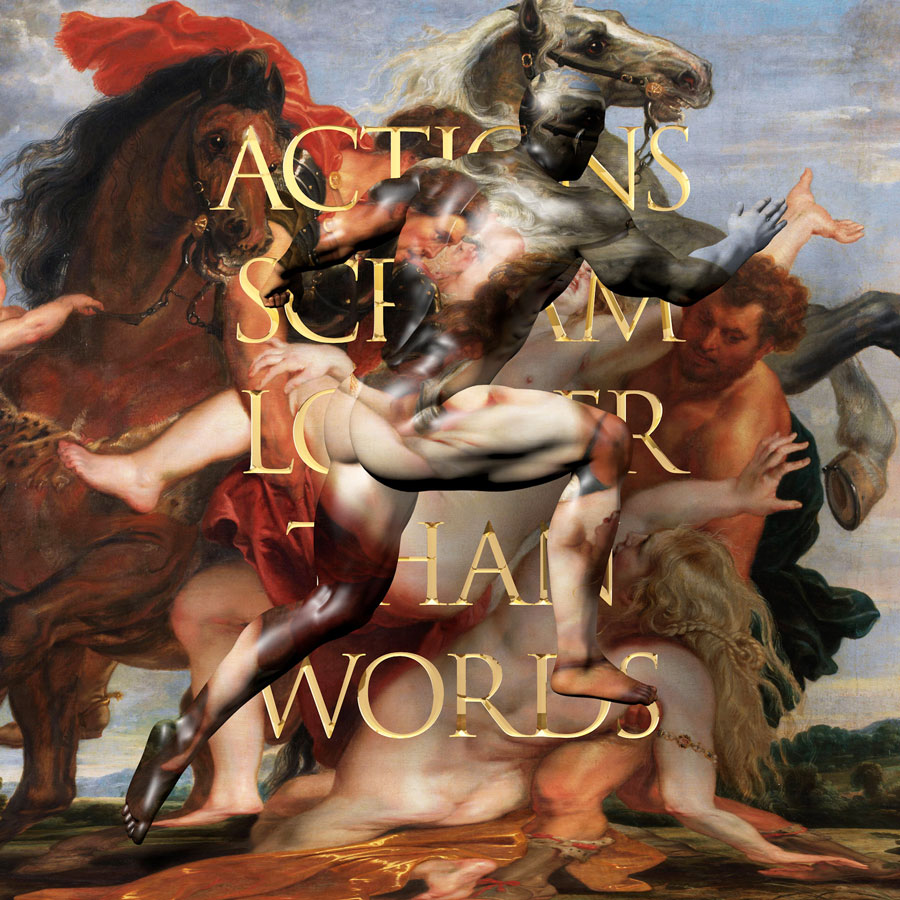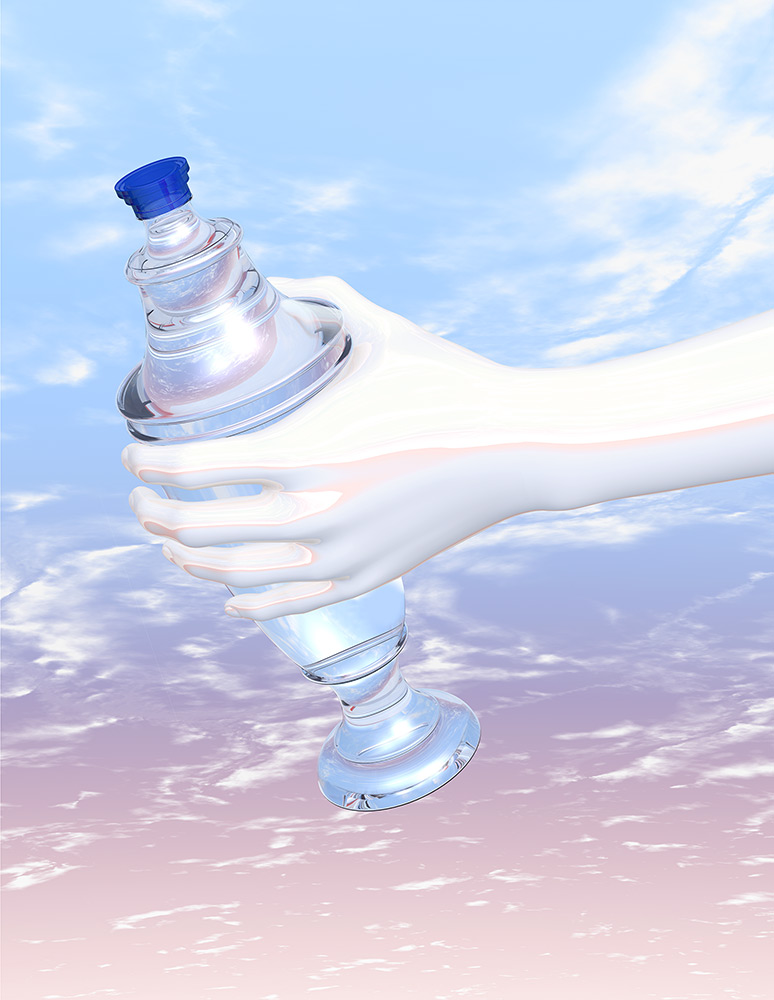
Howlcore
digital, 2021
Aesthetics of strength
The ability to control the power narrative is power itself.
Whether power comes from a position that is easily quantifiable (economical, political, military) or that position is merely a carefully constructed projection, a facade, a Potemkin village of implied ability to dominate the power balance in your favour, quite often the projection alone is a precursor if not a guarantee to achieving actual domination. As Eric Idle humorously observes in The Holy Grail, Arthur must be a king as he simply “hasn’t got shit all over him” as opposed to his subjects. The scene is so much more telling, as earlier in the film Arthur is a subject of a heated marxist discussion where another shit covered peasant named Dennis questions his legitimacy as sovereign. Perhaps cleanliness and mythology is not enough to successfully turn the power balance in your favour, but being able bodied amidst a plague epidemic certainly helps. Just as more recent plagues of syphilis and especially hiv virus clearly show, a healthy body is a corner stone when building moral superiority to legitimise the dominant position.

Palm bay fresh linen
digital, 2020
Appearance is the guiding force behind the power narrative that draws its strength in mythological origins, provenance and (pseudo) heritage. Heritage may not be a long lasting one, mythology is just as easily constructed in a short timespan of a rags to riches success story as potently shown by the concept of the American dream, where heritage comes from self determination backed by the righteousness of manifest destiny.
Aesthetic qualities emphasise strength trough the eternal, martyrdom, physical health and perfection to lay the foundations for legitimacy of power as we can observe in Jacques Louis David’s body of work. We could talk at length about the morally questionable art pieces of David, but what speaks volumes about his work is the ease with which he changed sides between Louis XVI, Robespierre and Napoleon. Propaganda from the hands of an opportunist? David was just as caught in the power narrative directed by more skilled protagonists, as he was an active component in spreading that narrative to the wider public. Beauty is not truth, but an item always on sale.

Reliquary
digital, 2020
If much of the power narrative is a careful pick and choose out of an amorphous cloud of half-truths and subjective story telling, an edited, censored and marketing friendly cut justifying ones right to hold the CEO position in the power hierarchy, then at least the visual appearance of this precarious vapor-space must be set in stone. For much of the time as literally as possible. The reassurance of classical Greco-Roman architecture, the gravity defying concrete structures of modernism and brutalism and the shopping mall-turned-temple visions of architectural post-modernism (often seamlessly fused together such as in the case of Kazakhstan’s Astana) make the building blocks of aesthetics of strength. A menagerie of marble and steel, exotic wood and concrete, aluminium, glass, carbon fibre, gold and gilding and its resistance to passage of time is nicely complemented by repetition of rituals and ceremonies and repetition of branded content. It would be easy to refer to Triumph of the Will as a telling example of how ceremony shapes the power narrative, but a more recent and subtle example will do just as well. The aesthetics of the border is the sheen of barbed wire, but also flags flying and officials ritualistically checking documents ad infinitum. It is no coincidence that the first objection when the integrity of the border was broken by the recent influx of (illegal) migrants crossing Europe was that they did not pass trough that very ritual of document checking. It is at the border (state, corporate, social or any other) that the power narrative sorts the competitors to their place.
Branding should also be interpreted as setting boundaries over what is allowed and what forbidden. While branded objects can be bought and owned, the constant presence of corporate branding in the intimacy of our homes show an internalised (in)voluntary subjugation of the user. I own but am owned. Branding, as indicating ownership (a farmer marking livestock), can be specially confusing when that ownership is seen by the user as a status symbol helping him to exert his influence over others (the nouveau riche proudly presenting their logo printed fashion accessories). While such strategies may be successful in part, it is good to remember that the borders of my world are the borders of copyright infringement.

Caryatids I
digital, 2020
Branding is always a corporate tool first, pomp and circumstance not for king and country, but for manager and company, showing a transfer of power to the hands of corpocracy, something easily observed in the way contemporary aesthetic of strength is portrayed. Yes, the Ionic column is still here and so is the Roman arch (and the mahogany boardroom), the finally conquered vertical dimension (Burj Khalifa) also adds its share to establishing the contemporary nouveau riche power narrative, where the corporation overtakes the state as the main modus operandi of organising a community. But as commercial spaces replace public spaces the aesthetics of strength changes as well by moving away from individual artistic vision towards a more broadly conceived and market friendly solutions suited to mass and social media. New prophets of the tech-theological domains in the veins Elon Musk draw much of their authority (and net worth) from a carefully constructed visual language, one no longer chiseled in marble, but covered in a cgi marble texture. A hyperloop render is worth a thousand operating Shinkansens.
—
“What is steel compared to the hand that wields it?” asks James Earl Jones trying to convince Conan to abandon his individualism and conform to the collective. But how does the hand (flesh, body), an easily corrupted material exude strength, capable of changing the power narrative? By imitation and intimidation.

Hyperloop
digital, 2020
The physical, living body is built and displayed as an imitation of its artistic portrayal in an effort to claim the mythological heritage of the artwork and the time in which it was made. The disc thrower of Leni Riefenstahl’s Olympia is not based so much in sports but in the representation of classical greek statues depicting that sport. The athletes/actors may well be freezing off camera, but their on screen presence is clear: body is just as strong as steel (or at least bronze), it can change the power narrative by self-control, hours/days/years long exercise regimes and dietary restrictions - by sheer power of will. Nudes of Bruce of Los Angeles share in that very same body-as-statue aesthetic. While one may be seen as dangerous furthering of racial ideology and the other as innocent homo-erotica, they both show how the body imitating its idealised representation can overcome its deficiency and project itself on par with a baroque palace or 21st century corporate headquarters.

Organic I
digital, 2019
Intimidation on the other hand can be interpreted as a direct threat of violence, but in a time when outside of MMA role playing any form of physical (and even verbal) confrontation is described as toxic masculinity such tactics can be counterproductive. Not that aesthetics of strength should be linked with masculinity alone, the contemporary fitness shaped body is inherently androgynous, a gender crossing ideal, a franchise of a body image seeking shelter under the herd protection of looking alike. Intimidation so works by defying ones genetic limitations - a self made (wo)man beating his/her physical predispositions and elevating societal status by doing extensive sets of push-up. The protein fueled zero-fat body dominates over other physiques by becoming the epitome of efficiency, intimidating others in submission by questioning their capability to do the same. While the healthy body, healthy mind maxim can be questioned when performance enhancing drugs are involved, increasing your net worth by increasing your body worth cannot.

Coexist I
digital, 2019
As the body finds strength in extreme efficiency, the word must conform to this as well. The contemporary text is one short on character count, a tweet composing a message trading depth of content for reaching an audience as wide as possible. Slogans, mottos, phrases and inspirational quotes project faux elegance trough simplicity, they speak of hidden knowledge distilled for easier consumption. It is the very brevity of text that is most aesthetically pleasing in the power narrative, one sourcing directly from over identification with a distorted reading of the Acta non verba adage. Proving your exaggerated and unfounded statements with measurable deeds is being replaced by favouring the user-friendly utilitarian perspective of act over complexity of intellectual debate (quite often used to shut it down). Word is no longer part of a conversation, a dialogue, but a one-liner sermon seemingly infused with wisdom.

Mortem autem Socrates
digital, 2018
As actions seem to scream louder than words, words must become few in numbers in order to at least be heard as you cannot shout a 500 page essay. In cyberspace brevity is even further compressed, as it is the not the word that is most aesthetically pleasant, but number, the number of followers solidifying ones position in the power hierarchy and impossible to argue with.
—
What spaces are preferred stages for power narratives to play out? Public squares, capital centres, business districts are an obvious answer, but one that lends itself to an overtly romantic and archaic gaze. Exteriors are always meant for the visitor, the traveler, for the casually or erroneously summoned as wonderfully seen in Kafka’s Castle where K. cannot enter the castle itself, his destiny kept in limbo by an unseen ever present authority whose power narrative is based on the very locked doors K. cannot pass trough.

Actions scream louder than words
digital, 2017
It is the interior that holds the secrets and the very strict hierarchy acts as a sieve that only lets the worthy (adversary) in. As mahogany boardrooms, in-house private galleries and executive gyms give way to an infantilised Pinocchio treasure island style of Google offices, the barrier remains the same, fuelling eternal desire by an ever changing visual language of wealth and excess - aesthetics of strength you can never shape, but merely like on your Instagram profile.

Devolvat bestiam
print on PVC textile, 150 x 250 cm, 2016
Not that there is no middle ground between the castle and the village, the top floor boardroom and the lobby. In the past that space was the bourgeois apartment filled with bourgeois art, art that can be measured - quite literally. The bigger the marble statue, the better, more work invested in making a painting, more value. It is in the measurable that the legitimacy of ones position in society is drawn from, utilising not only the beauty of the artwork, but more importantly the amount of time and craft that went into producing it. Of course, these spaces were, as they are now, still off limits (bar a piano teacher or the maid), so what are contemporary interiors we can enter, but be made feel the eternal other, even after paying the admission fee? Places both open and closed at the same time? The shopping mall comes to mind, but even more precarious interiors have been built, interiors both real and hiperreal at the same time, such as new biotopes of Ski Dubai or Tropical Islands near Berlin. But as we turn our eyes and hopes to the meta reality of VR to become the future bearer of paying for being a part in someone else’s power narrative, it should be noted that reality has been broken before. Aesthetic of strength has always been utilised to inspire and give legitimacy to power structures trough entirely fictional and even impossible to construct structures. What else if not a precursor to the contemporary CGI are Speer’s Germania or Boullee’s Cenotaph for Newton?

Sanctuary
MDF, brass, carbon fiber composite, anodised aluminium, granite, EO1 screen, 2016
So where do fitness, wellness, yoga and spiritual centres fit in among other previously described transient spaces? Seemingly democratic, definitely capitalist, open to the public 24/7, they are designed to keep others out, and you safe. As longevity and efficiency form the new quality of life paradigm, they serve as a sanctuary from the power play one cannot win, although must compete in. The rags to riches story is still a scam, remember the (supposed) ending to The Castle, where after his death K. finally gets a definitive answer, his presence is illegal, although he will be permitted to work in the village, but the castle will forever be out of his reach. Body (and spirit) building thus becomes ego building, not to win the power narrative, but to survive in it by conforming to the idea that at least we can all be victims, as we can’t all be champions. Coexisting in isolation from both the weak and the truly powerful, caught mimicking the aesthetic of strength with six pack abs.
© KladnikNeon 2015-2021

Purple skies
digital, Kaleidoscope magazine, 2015













